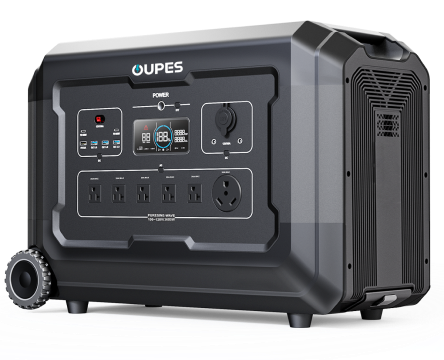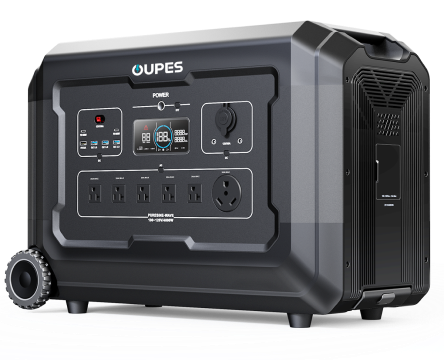The portable power station has a compact design and versatile energy capabilities. It has evolved into an essential tool across various environments. These devices are crafted to deliver convenient access to electrical power on the move.
Portable power stations are used to charge and operate a range of electronic devices and appliances. So, they comprehend the breadth of what a portable power station can power is pivotal for maximizing its functionality. But what can a portable power station run? Keep reading to find out!
How Do You Know If Your Portable Power Station Can Power an Appliance?
The range of appliances a portable power station can support depends on several factors, including the following:
- The storage capacity of the portable power station
- The power output capacity of the portable power station
- The wattage requirements of the devices you intend to operate simultaneously.
Portable power stations generally excel in charging smaller items like phones, fans, and tablets. It is important to know if your portable power station can accommodate more power-intensive devices.
When selecting a portable power station, consider adding extra watts to its capacity. This accounts for the connected appliances' surge power or startup current.
Devices, such as air conditioners (AC), have a consistently lower operational capacity compared to the surge capacity required for initial activation. For instance, the surge power during the startup phase can be 2-3 times the standard power consumption.
Once the appliances are in regular operation, they will run on legal power. They will also maintain a continuous and consistent electricity consumption. Read below to find out which appliances a power station can run.
Is It Possible to Power a TV with a Portable Power Station?
Yes, you can easily power your TV with a portable power station. You can also use it to power other devices, such as laptops, radios, CD players, and more. Modern televisions, especially LED models, have a relatively low hourly wattage, ranging between 50 to 200 watts per hour.
It is vital to ensure your power station can simultaneously power a TV and other devices.
The battery runtime varies if you run many appliances together. For example, if you want to stream internet content or connect more devices to the portable power station, you must consider their wattage.
For instance, charging various devices affects the total energy consumption. It also impacts the duration between power station charges.
Can a Portable Power Station Power Your AC Unit?

The compatibility between a power station and an air conditioner depends on their specifications. Verify the power station's inverter rating and the wattage requirements of the air conditioner you intend to connect.
Each air conditioner model is distinct and unique. So, you need to check the starting and running watts of each air conditioner by reading through the handbook specifications manual. You can also contact the manufacturer directly.
Air conditioning units exhibit wattage differences, but they all demand significant power. Central air conditioning units typically consume around 3000 to 3500 watts per hour. Larger portable units operate between 2,900 and 4,100 watts per hour, while window units usually use between 900 and 1,400 watts per hour.
Can a Portable Power Station Power a Refrigerator?
The more potent power stations can effectively power your refrigerators. A typical refrigerator consumes approximately 1 to 2 kWh per day. The wattage demand is influenced by factors like size, model, and temperature settings.
Most power usage occurs during startup and when the compressor is operational. So, increased compressor activity can lead to higher energy consumption.
Typically, a refrigerator may need up to six times its rated current for surge power during startup. The appliance's startup needs are often indicated as the Locked Rotor Amp (LRA) value, measured in amps. To determine the required wattage, you can multiply the amps by volts.
You need to consider the efficiency ratings of your refrigerator. They provide insights into its performance.
Consider the OUPES 2400 Portable Power Station, a device adept at sustaining a 150-watt refrigerator for an impressive span of 17 to 30 hours. This signifies that, even amidst a power interruption, you can persist in energizing essential appliances, like your refrigerator, with this dependable domestic backup power solution.
How Do I Know What Size Portable Power Station I Need?
Selecting the appropriate size for a portable power station hinges on your intended usage. To determine the ideal size, perform some calculations. Begin by identifying the wattage required by your devices. If your devices specify amps, multiply by the voltage to get watts.
Next, establish the duration each device will be used. Multiply the hours by the device's wattage to calculate the total watt-hours needed.
To accommodate energy inefficiencies, divide the total watt-hours by 0.85. This outcome represents the lowest capacity of the power station you should consider.
It's crucial to note that many consumers use a power station for a single device and versatile power access in diverse situations. Ensure that your chosen power station aligns with a range of power needs at home and in business settings.
Benefits of a Portable Power Station

Portable power stations offer a variety of advantages, addressing a broad spectrum of needs and scenarios.
Versatility
Portable power stations offer the flexibility to charge and power various electronic devices. These devices range from smartphones and laptops to small appliances and power tools.
User-Friendly Operation
The functionality of portable power stations is user-friendly. For instance, it is designed with straightforward interfaces and many charging alternatives. It also occasionally incorporates smartphone apps for monitoring and control.
For aficionados of the OUPES MEGA series portable power station, the OUPES App offers an intricate and comprehensive interface to oversee your device. Here, you can meticulously monitor and manipulate various facets of your power station's functionality, encompassing the instantaneous inflow and outflow of power, the condition of assorted ports, and the nuanced details of the connected auxiliary battery units.
Quiet Operation
In contrast to conventional generators, most portable power stations operate quietly. This renders them appropriate for use in tranquil environments. They can also be ideal in situations where noise sensitivity is a consideration.
Emergency Preparedness
During power outages or emergencies, a portable power station can be a dependable electricity source. For instance, you can use it to power vital devices such as lights, communication tools, medical equipment, and beyond.
Conclusion
A portable power station enables you to maintain the operation of essential appliances during power outages or off-grid scenarios. This ensures you can continue to enjoy your television, air conditioning, or refrigerator.
The OUPES offers a variety of power ratings. They all feature LCDs displaying the estimated duration until the next recharge for your Portable Power Station (PPS). They also have a mobile app that provides comprehensive information about your portable power supply. This keeps you well-informed about its status and performance.

































Leave a comment
This site is protected by hCaptcha and the hCaptcha Privacy Policy and Terms of Service apply.